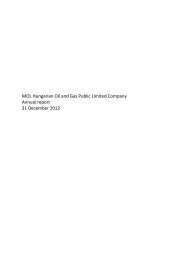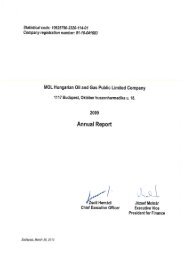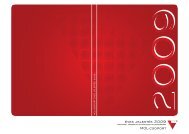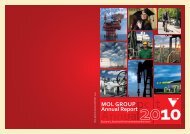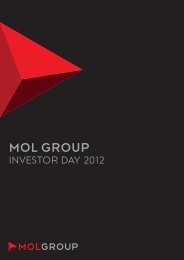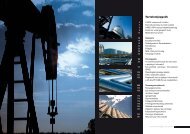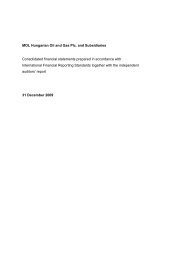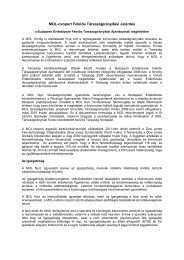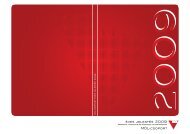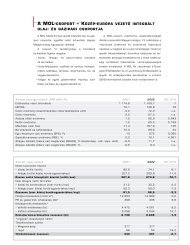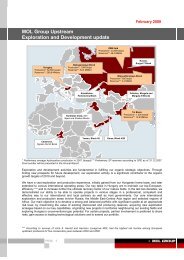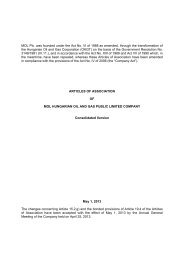DOCUMENTS FOR THE ANNUAL GENERAL MEETING
DOCUMENTS FOR THE ANNUAL GENERAL MEETING
DOCUMENTS FOR THE ANNUAL GENERAL MEETING
Create successful ePaper yourself
Turn your PDF publications into a flip-book with our unique Google optimized e-Paper software.
MOL Plc. Annual General Meeting 2013 Documents<br />
More emphasis on Retail<br />
and Logistics due to a<br />
changed market situation<br />
CAPEX should be financed<br />
from operating cash-flow in a<br />
flexible way; USD 1.5 bn in<br />
2013<br />
M&A: Active portfolio<br />
management has priority in<br />
Upstream<br />
Another key area for focus is how to cope with the difficult situation<br />
of shrinking demand. In such a difficult business environment, the<br />
importance of the captive market concept has increased all the<br />
more. This is especially true in the gasoline market. Here we aim to<br />
expand our retail network in the region further and rationalise and<br />
then increase our Retail portfolio. The focus is on areas which<br />
provide captive markets, good profitability and growth<br />
opportunities. Finally, we are committed to continuing the refinery<br />
modernisation program in Rijeka, Croatia. Final investment decision<br />
is expected after the basic design of the unit is completed.<br />
In principle, all our organic CAPEX spending should be fully covered<br />
by operating cash flow. While in 2013 our organic CAPEX program<br />
requires USD 1.5bn in the mid-term, we are maintaining our up to<br />
USD 2 bn per annum guideline. More than 50% is allocated to<br />
Upstream, 28% to Downstream, 3% to Gas and the remainder serves<br />
as a contingency fund. On the other hand, MOL continuously<br />
monitors both growth opportunities and the external environment<br />
so as to be able to react in a flexible way in CAPEX spending.<br />
As far as our M&A activities are concerned, we are open to adding<br />
new elements to our Upstream portfolio just as we did in Russia,<br />
Oman, Kazakhstan and Egypt in 2012. We prefer entering projects in<br />
their early, exploration phases, where most of the value is created. It<br />
should be noted, however, that in all cases, balance between cash-in<br />
and cash-out cycles should be approximately balanced so as to be<br />
active in farm-outs as well to optimise our financing and risk profile.<br />
In Downstream, in line with the above-mentioned captive market<br />
strategy, we are further extending our Retail network.<br />
UPSTREAM OVERVIEW<br />
Highlights<br />
EBITDA, excluding special items, reached HUF 417bn, below 2011<br />
results due to lack of a Syrian contribution, worth HUF 75bn in<br />
2011.<br />
<br />
<br />
<br />
<br />
The Group’s total SPE 2P reserves stood at 647 MMboe as of 31 st<br />
December 2012.<br />
Current best estimates of unrisked recoverable resource<br />
potential is 1.6 Bboe (on a working interest basis) from 11<br />
countries, which will be derisked in the coming years (725<br />
MMboe in the Kurdistan Region of Iraq, 135 MMboe in<br />
Kazakhstan).<br />
In 2013, we are expecting around 110 mboepd hydrocarbon<br />
production, without any Syrian contribution.<br />
As a result of successful Kurdistani activities, the first barrels from<br />
the region will contribute to production in 2013.<br />
9/94



